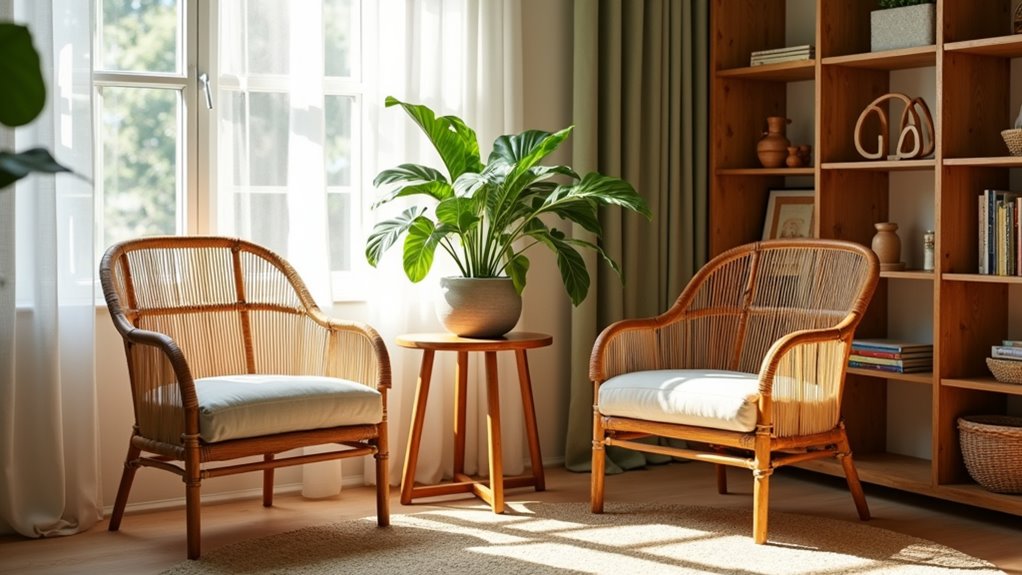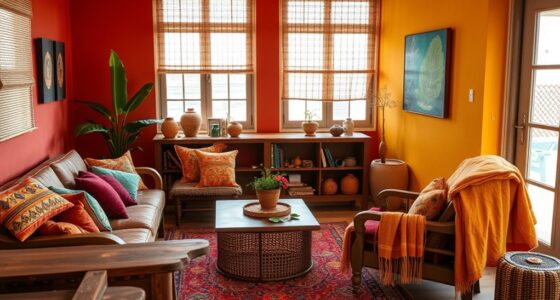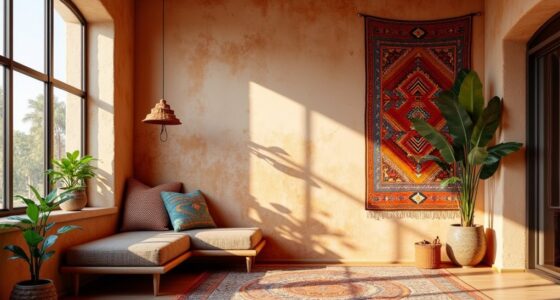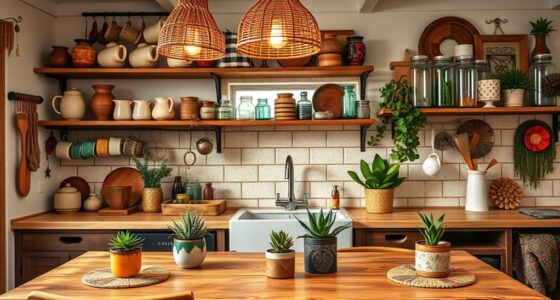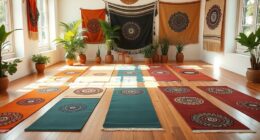Using bamboo, rattan, and reclaimed wood in your DIY projects not only adds natural beauty and warmth but also supports eco-friendly living. You can create stylish room dividers, furniture, lighting, and decor accents with these sustainable materials. Regular maintenance and upcycling enhance their longevity and charm. If you stick around, you’ll discover more creative ideas and practical tips to incorporate these materials seamlessly into your home design.
Key Takeaways
- Choose sustainable, fast-growing materials like bamboo and rattan to minimize environmental impact in DIY projects.
- Incorporate natural textures and finishes to add warmth and authenticity to home decor.
- Use reclaimed wood and upcycled elements for eco-friendly, unique furniture and accents.
- Maintain materials regularly with gentle cleaning and natural oils to extend lifespan and preserve appearance.
- Combine these materials creatively for functional decor such as lighting, shelving, and room dividers.
Selecting Sustainable Materials for Your DIY Projects
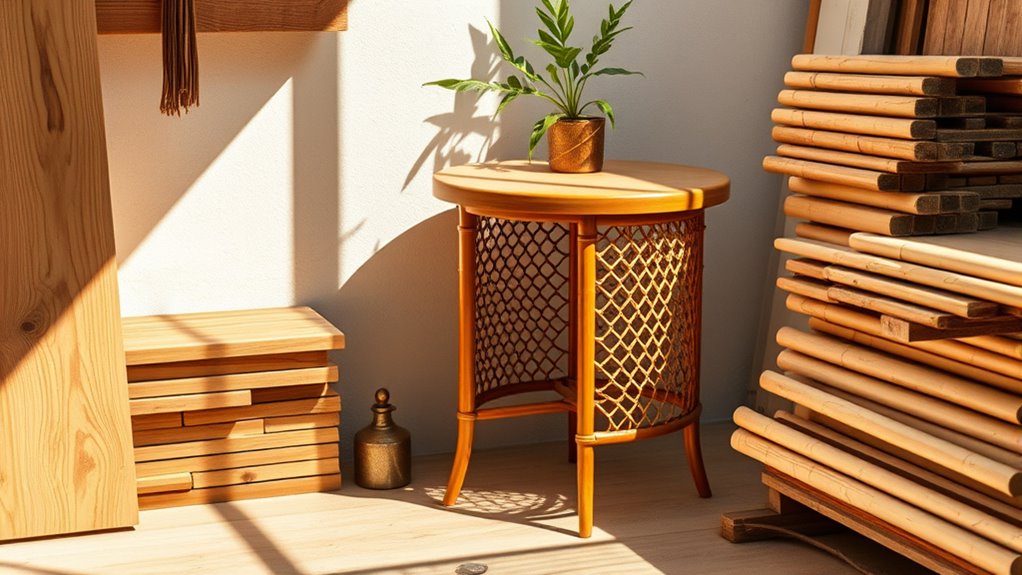
Choosing sustainable materials for your DIY projects not only benefits the environment but also adds natural beauty to your creations. Opt for eco-friendly options like bamboo, which is a highly renewable resource, growing up to 35 inches daily and maturing in just seven years. Reclaimed wood is another excellent choice, reducing waste and minimizing the environmental impact of new timber. When sourcing wood, look for FSC-certified or locally sourced options to guarantee responsible harvesting. Fiber materials from rattan, a rapidly renewable vine, can be sustainably harvested multiple times without harming ecosystems. These natural textures bring warmth and authenticity to your projects, making your DIY endeavors both environmentally friendly and visually appealing. By selecting these sustainable materials, you support conservation efforts and craft with purpose. Additionally, incorporating AI-driven insights can help you choose the most sustainable options based on environmental impact data. Recognizing the importance of renewable resources can guide you in making more eco-conscious choices for your projects. Utilizing natural materials also ensures that your creations remain free from synthetic chemicals often found in non-sustainable alternatives. Moreover, selecting materials with minimal processing reduces carbon footprint, further enhancing the eco-friendliness of your projects.
Creative Ways to Incorporate Bamboo, Rattan, and Wood
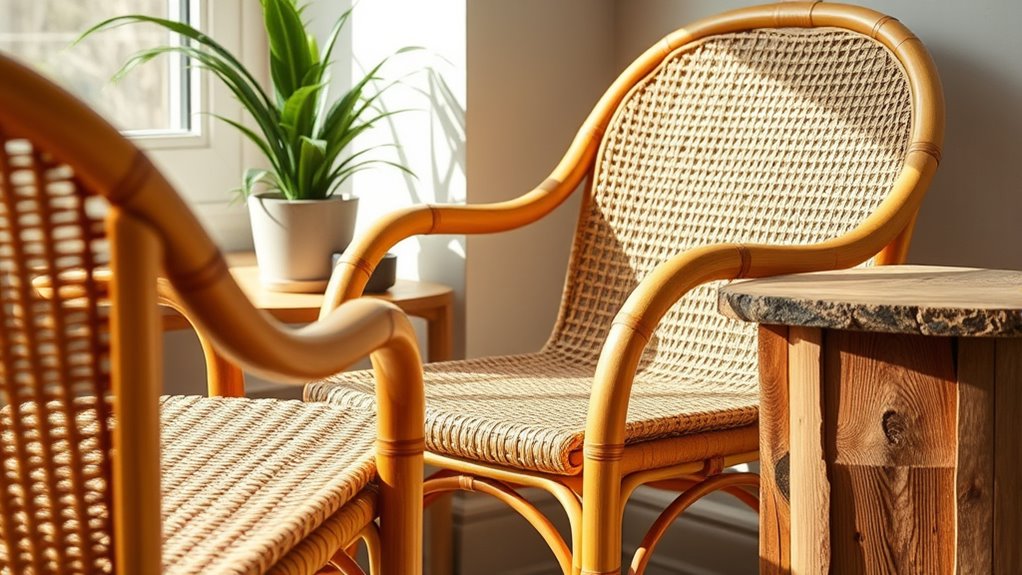
Incorporating bamboo, rattan, and wood into your DIY projects can instantly add natural charm and warmth to any space. Use bamboo fencing as room dividers or wall paneling to create an organic tropical vibe, showcasing its versatility and sustainability. Rattan accents, like baskets or lampshades, introduce natural texture and eco-friendly appeal. Combine reclaimed wood and rattan to craft custom furniture pieces such as side tables or headboards, adding rustic layers to your home decor. Enhance lighting with bamboo or rattan fixtures for warm, inviting illumination that complements your interior design. These sustainable materials can be refinished with low-VOC paint and natural hardware, allowing you to upcycle existing furniture while embracing an eco-friendly aesthetic. This approach makes your DIY projects both stylish and environmentally conscious, and developing attention to detail can elevate the overall quality of your craft. Additionally, selecting environmentally friendly finishes and fasteners ensures that your projects remain sustainable from start to finish.
Upcycling and Repurposing With Natural Elements
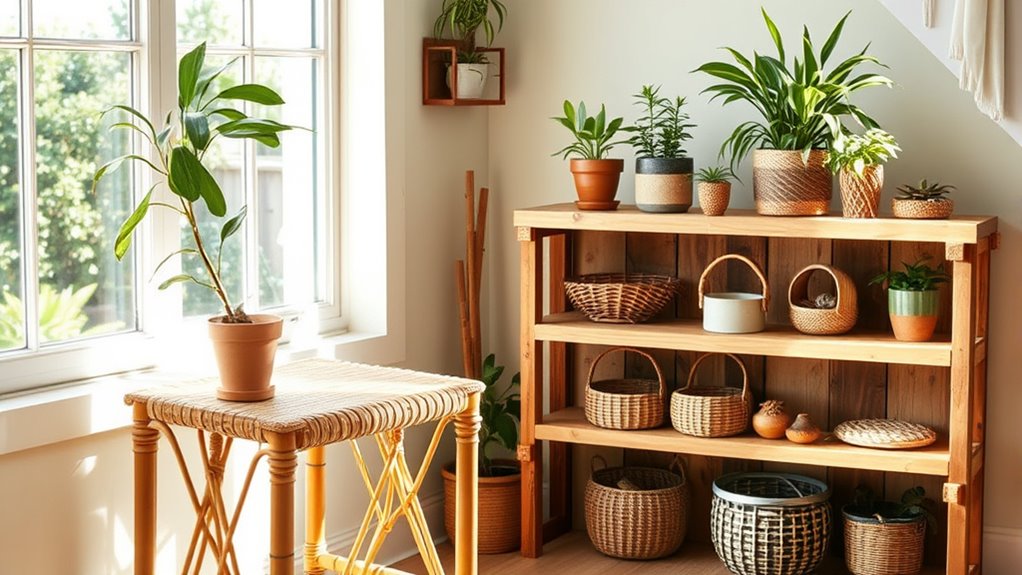
Upcycling and repurposing natural elements like bamboo, rattan, and wood offer a sustainable way to refresh your home decor while reducing waste. By transforming old furniture or scraps into stylish, functional pieces, you give new life to natural materials. Sanding and repainting vintage wooden items with low-VOC paints make them look fresh and eco-friendly. Reclaimed wood can be used to build modular shelves or storage with sustainable hardware like cotton straps, adding softness and flexibility. Incorporate woven textiles or rattan baskets to turn scraps into unique accents. Small DIY projects, such as creating jewelry or decorative items from scrap wood, ceramic shards, or recycled metals, allow you to craft personalized, eco-conscious decor that enhances your space while supporting sustainability. Additionally, integrating natural materials like wood and rattan can boost the overall aesthetic and durability of your creations.
Tips for Maintaining and Caring for Natural Materials
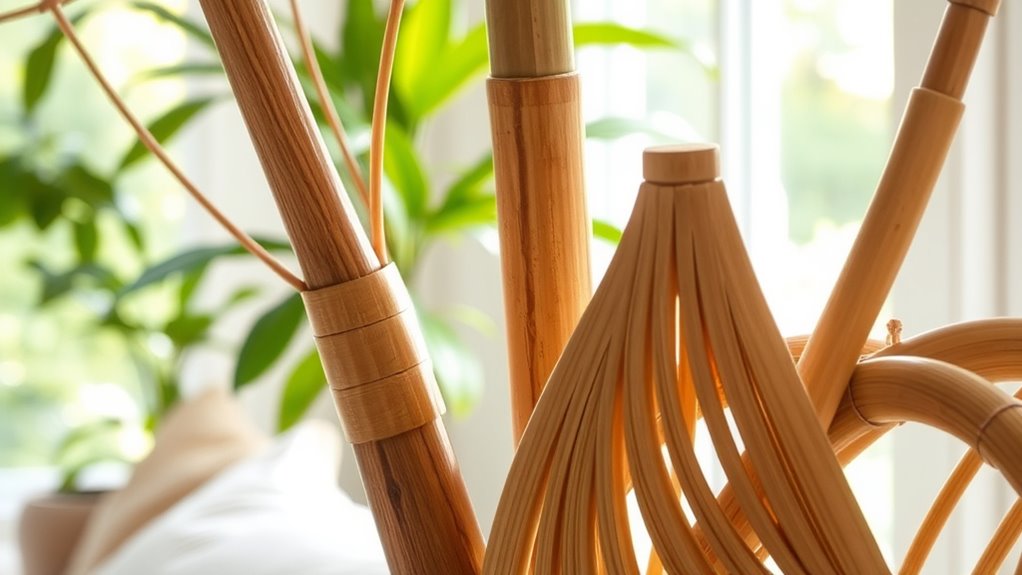
To keep your natural materials looking their best, regular maintenance is essential. Proper care guarantees your DIY projects retain their beauty and durability. Here are three key tips:
Regular maintenance preserves the beauty and durability of your natural materials.
- Dust bamboo, rattan, and wood surfaces frequently with a soft cloth to prevent dirt buildup and preserve their natural appearance. Using a fabric decorating marker can also help touch up minor scratches or imperfections, maintaining a fresh look. Being mindful of exposure to sunlight can help prevent fading and warping over time. Additionally, avoiding prolonged exposure to air pollution can help protect these materials from environmental damage.
- Use a damp cloth with mild soap or specialized wood cleaners periodically for effective cleaning and to support wood care.
- Apply a natural oil or sealant, like linseed or tung oil, every 6-12 months to nourish fibers and protect against damage and wear.
- Be mindful of toilet cleaning products, as some harsh chemicals can damage natural finishes and fibers over time. Additionally, understanding the significance of dream symbols can help you better interpret subconscious messages related to your home environment and personal well-being.
Avoid prolonged sunlight and moisture exposure, which can cause fading, warping, or cracking. Prompt damage repair with filler or glue will extend the lifespan of your natural materials, ensuring your home interior remains stunning.
Inspiring Design Ideas for Eco-Friendly Home Decor
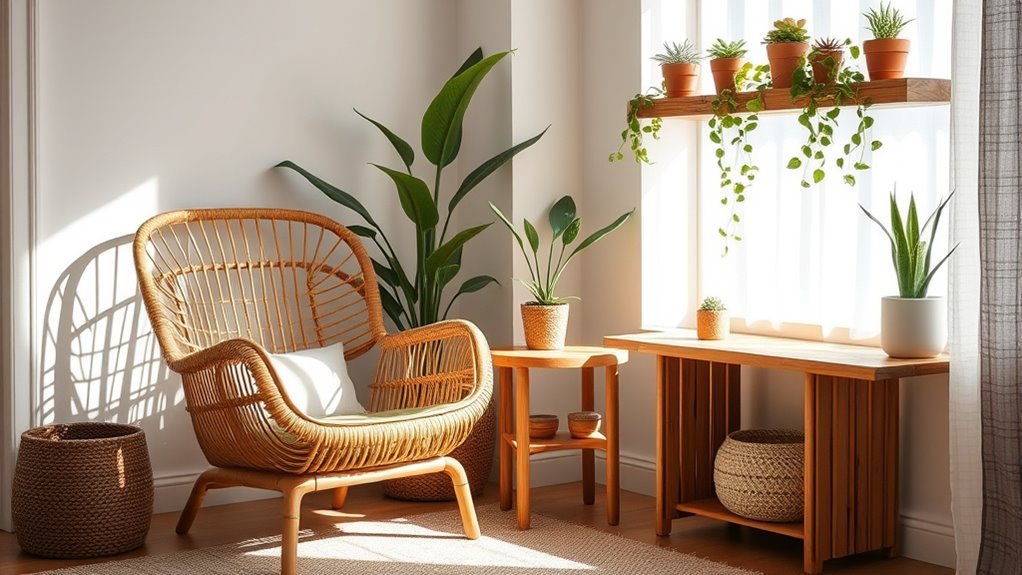
Eco-friendly home decor often features bamboo, rattan, and wood because these natural materials bring warmth and texture while supporting sustainability. You can incorporate bamboo fencing or create textured walls with woven rattan to add organic beauty and depth to your space. DIY home decor projects with bamboo products, like lighting fixtures or shelving, showcase eco-friendly design and elevate your interior design. Reclaimed wood accents add vintage charm and authenticity, blending sustainable materials with timeless appeal. These natural elements not only enhance aesthetic appeal but also promote healthier indoor environments by improving air quality. Using bamboo, rattan, and wood allows you to craft stylish, eco-conscious decor that celebrates organic beauty while reducing your environmental footprint. Additionally, choosing sustainable cultivation methods for these materials ensures that their use continues to support environmental health and biodiversity.
Furthermore, selecting renewable resources helps maintain ecological balance and promotes long-term sustainability in home decor projects.
Frequently Asked Questions
How Do I Identify Sustainably Sourced Bamboo and Wood?
When you’re trying to identify sustainably sourced bamboo and wood, start by checking certifications like FSC or PEFC on labels. These guarantee responsible harvesting practices. Look for suppliers that provide transparent information about their sourcing and ask about their environmental policies. Avoid products with excessive packaging or labels that lack details. By doing your research and choosing reputable sources, you help support sustainable forestry and eco-friendly practices.
What Are Common Mistakes to Avoid When Working With Rattan?
Did you know that many DIYers stumble with rattan because they don’t prep it properly? You should avoid rushing to bend or cut rattan without soaking it first, as it can crack or break. Also, don’t neglect cleaning and sanding before finishing—poor preparation leads to weak joints or uneven surfaces. Always handle rattan gently and follow manufacturer instructions to guarantee your project stays durable and beautiful.
Can Natural Materials Be Used Outdoors Without Weather Damage?
You can use natural materials outdoors, but you need to take precautions. Without proper treatment, bamboo, rattan, and wood can be damaged by weather, such as rain, sun, and humidity. To protect them, seal or varnish the surfaces, and consider using covers or placing furniture in sheltered areas. Regular maintenance helps extend their lifespan, keeping your outdoor space beautiful and durable despite the elements.
Are There Non-Toxic Finishes Suitable for Bamboo, Rattan, and Wood?
You’re wondering if non-toxic finishes suit bamboo, rattan, and wood. The good news is, yes, there are eco-friendly options like water-based polyurethane, tung oil, and beeswax that protect your materials without harmful chemicals. These finishes enhance durability and beauty while keeping your home safe. Always check labels for non-toxicity, and apply in well-ventilated areas to guarantee your project stays eco-friendly and healthy.
How Can I Blend Natural Materials With Modern Interior Styles?
You can blend natural materials with modern styles by pairing sleek, minimalist furniture with bamboo, rattan, or wood accents. Use neutral colors to highlight the natural textures and keep the space feeling fresh. Incorporate clean lines and simple shapes to create contrast, and add contemporary decor like metal or glass elements. This balance enhances a warm, inviting atmosphere that seamlessly combines organic charm with modern elegance.
Conclusion
By choosing natural materials like bamboo, rattan, and wood, you’re not only creating beautiful, eco-friendly home projects but also supporting sustainability. Did you know that bamboo grows up to 35 inches in a single day, making it one of the fastest renewables? Incorporating these materials helps reduce environmental impact and adds warmth to your space. So go ahead—embrace these natural elements and make a positive difference with your DIY projects.
